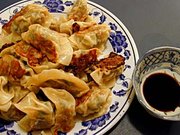Dumpling
|
|
Dumplings may be any of a wide variety of dishes, both sweet and savoury, in several different cuisines. They are either made from balls of dough or are small parcels of food encased in pastry, dough, batter, or leaves.
| Contents |
United States
The baked dumpling is popular in the United States. These sweet dumplings are made by wrapping fruit, frequently a whole tart apple, in pastry, then baking until the pastry is browned and the filling is tender. As an alternative to simply baking them, these dumplings are surrounded by a sweet sauce in the baking dish, and may be basted during cooking. Popular flavours for apple dumplings include brown sugar, caramel, or cinnamon sauces.
Southern States
Boiled dumplings are made by mixing eggs and flour to form the easily pinched off dough. A pot of boiling chicken or turkey broth is used to cook the dough. The size of the dumplings is the choice of the cook and does not affect the taste, but can have an effect on the texture. It is optional to serve with the meat in the dish or on the side.
British cuisine
Savoury dumplings made from balls of dough are part of traditional British cuisine, and make up a filling meal in winter. The simplest dumplings are made from twice the weight of self raising flour to suet, bound together by cold water to form a dough. Balls of this dough are dropped into a bubbling pot of stew or soup, or into a casserole. They sit, partly submerged in the stew, and expand as they are half-boiled half-steamed for ten minutes or so. The cooked dumplings are airy on the inside and moist on the outside. The dough may be simply flavoured with salt, pepper and herbs, or the dough balls may have a filling such as cheese pressed into their centre.
Other British dumplings call for the addition of breadcrumbs and cheese, and the balls of dough may be rolled in breadcrumbs and fried, rather than cooked in a soup or stew.
These dough dumplings, when sweetened and made with dried fruit and spices can be boiled in water to make a quick dessert. In Scotland, this is called a clootie dumpling, after the cloth that is used to hold it together in the water
Central Europe
Germany, Austria, and Bohemia boast a large variety of dumplings both sweet and savoury. A dumpling is called Kloß in Northern Germany, Knödel in Southern Germany, and knedlíky in Bohemia. Meat dumplings are also called Klopse in North-Eastern Germany. Occasionally, the terms Knöpfe and Nocken are also used.
Potato dumplings are made with raw or boiled potatoes, or a mixture of both, and are often filled with croutons. Bread dumplings are made with white bread and are sometimes shaped like a loaf of bread, and boiled in a napkin, in which case they are known as napkin dumplings. Semolina dumplings are made with semolina. Meat dumplings, bone marrow dumplings and liver dumplings are frequent additions to soup. The most famous German meat dumplings are Königsberger Klopse from East Prussia, which contain anchovy or salted herring and are eaten with caper sauce.
Some sweet dumplings are made by wrapping quark dough, less frequently potato dough, around whole plums or apricots. Others are made of yeast dough and filled with jam.
Eastern Europe
Perogies are savoury or sweet filling, wrapped in dough. They are usually boiled, or fried when served as left-overs. Often served with plenty of sour cream.
Pirozhki, "little perogies", are tiny filled buns.
In Ukrainian cuisine, Vushka ("little ears") are folded triangular perogies stuffed with mushrooms. They are traditionally served in the borshch at Christmas Eve dinner.
Chinese cuisine
The jiaozi is a Chinese dumpling which consists of meat and minced vegetables wrapped into a piece of dough. Popular meat fillings include shrimp, ground lamb, ground pork, ground beef, and even fish. Jiaozi are usually steamed or boiled. If they are fried, they are called potstickers. Compared to wontons, jiaozis have a thicker skin and are longer.
The baozi is another Chinese dumpling, made with a thick leavened bun, compared to the thin noodle-like skin of jiaozi.
Zongzi are a traditional Chinese food. Sticky rice is used to fill a parcel made from dried lotus or bamboo leaves. The parcels are steamed for several hours to cook the rice, and when unwrapped they retain their shape. The dumplings may be eaten plain with syrup, or the rice is flavoured with meat and vegetables or mashed beans before cooking.
See also: dim sum for descriptions of several other kinds of dumplings such as gau and taro root dumplings.
Japanese cuisine
Fried Japanese dumplings made from eggs and eaten with dashi are known as akashi no tamagoyaki. Similarly shaped dumplings, but with octopus and flavoured with pickled ginger, konyaku, leek and other ingredients, are a Kansai dish known as takoyaki.
See also: gyōza a Japanese/Chinese dumpling.
Korean cuisine
Korean meat dumplings are called mandu (만두). They are typically filled with a mixture of ground pork, scallions, and garlic, and eaten boiled; sometimes they are fried.de:Kloß

